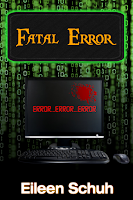When I was writing KidLit articles for the PopSyndicate website, several times I pestered the local librarian for answers, interviews, comments, and links. She was exceptionally obliging and I couldn't help but mention to her that my first published novel, SHRODINGER'S CAT would be released in 2011.
 |
| Caroline Vandriel |
Although each municipality and each school system in my home province is responsible for its library service, "library systems" were established several years ago to increase the buying power of individual libraries and promote the sharing of resources and information throughout the province.
So, although I am a member of my local St. Paul library I had never met Caroline Vandriel, Library Consultant from the Northern Lights Library System (NLLS), except online. I was thrilled when, after she discovered one of her coworkers was a close friend of mine, she suggested we meet for coffee.
"A librarian? That's HUGE!" said Cheryl Kaye Tardif, my book marketing coach. I thought just being invited for coffee by anybody was huge (those who are lonely writers will understand that).
On the otherhand, this meeting was special--because librarians and libraries occupy very special places in my heart. I have many warm memories of libraries--the shelves and shelves of books. The pictures. The stories. The knowledge. The smell. The hush. The sound of pages turning.
Lately though, tension between authors and libraries has been in the headlines and I was, after all, now an author as well as a reader. Questions being batted around included, 'Who owns what rights to the books within the library walls?' and 'Who is responsible for reimbursing the authors for the work they invested in those books?'
With these concerns in mind, I pondered what I should discuss with Caroline. What should I ask? What should I say? Did she drink her coffee black or does she drink tea?
A few days before my coffee date, I received an email from an author who lives not all that far from me, asking if I had information on how to get his self-published books into schools and libraries. Ah, I thought. That is a good question for Caroline.
I started a list:
- When my book comes out in 2011, is Caroline the one I'd contact about purchasing it for the local libraries?
- Who would I contact to participate in literacy events in the region?
- Since PopSyndicate had folded, was there any opportunity to continue my KidLit column on the NLLS website?
- Were there other ways that libraries and authors network?
- What else did she do?
- Was she going home for Christmas? Where was 'home'? Does she have siblings?
These are the answers I received:
- Caroline could suggest my book to member libraries within the Northern Light Library System, but it would be them, not her, who would decide if they want my book.
- Individual libraries organize their own events and promotions. She could give me the names of the libraries and contacts in my region.
- She is responsible for the Northern Lights Library System website. She'd consider my offer to contribute a KidLit column to the quarterly online newsletter.
- Once a year, a convention is held for all those involved with the regional libraries. Sometimes library people from other areas of the province also attend. Authors sometimes do presentations at the conferences and at times have showcased their work. She'd keep me informed on the plans for next year's convention and keep me in mind as a possible participant.
- What else is in her job description? She is the one who researches answers to questions people pose to all the libraries in her jurisdiction. What a cool service! (I've already sent her a question: What are these "cables" that Wikileak is leaking? Emails? Telegrams? She hasn't found the answer yet.)
- I won't share Caroline's answers to the personal questions. Suffice it to say it was a wonderful coffee date. And I came to understand the importance of networking with the libraries.
I was happy with my questions and happy with the answers, but I wanted to know if I'd missed anything huge. "Cheryl," I emailed. "Why would authors want to network with libaries?"
 |
| Cheryl Kaye Tardif |
She sent me her top ten reasons:
Why writers would want to network with libraries...
1. Libraries BUY books.
2. People still use libraries and will continue to do so.
3. Libraries are getting into ebooks.
4. Libraries love author visits.
5. Libraries often have other events you can attend.
6. You can arrange to sell your books to patrons during events in a library.
7. Libraries know other authors to which you can connect.
8. Libraries give your books more exposure.
9. Public Lending Rights Commission will pay Canadian authors every year based on how many of their works are in public libraries, while Access Copyright pays authors for the use of their work in educational systems (& elsewhere).
10. You’ll be able to tell readers your books are in the library.
For more great writing tips visit author and book coach, Cheryl K Tardif's, blog http://www.cherylktardif.blogspot.com/
I suggest all authors investigate the connection between libraries and authors in their area. Perhaps invite your librarian on a coffee date!
Eileen Schuh
Author SCHRODINGER'S CAT
http://www.eileenschuh.com/














